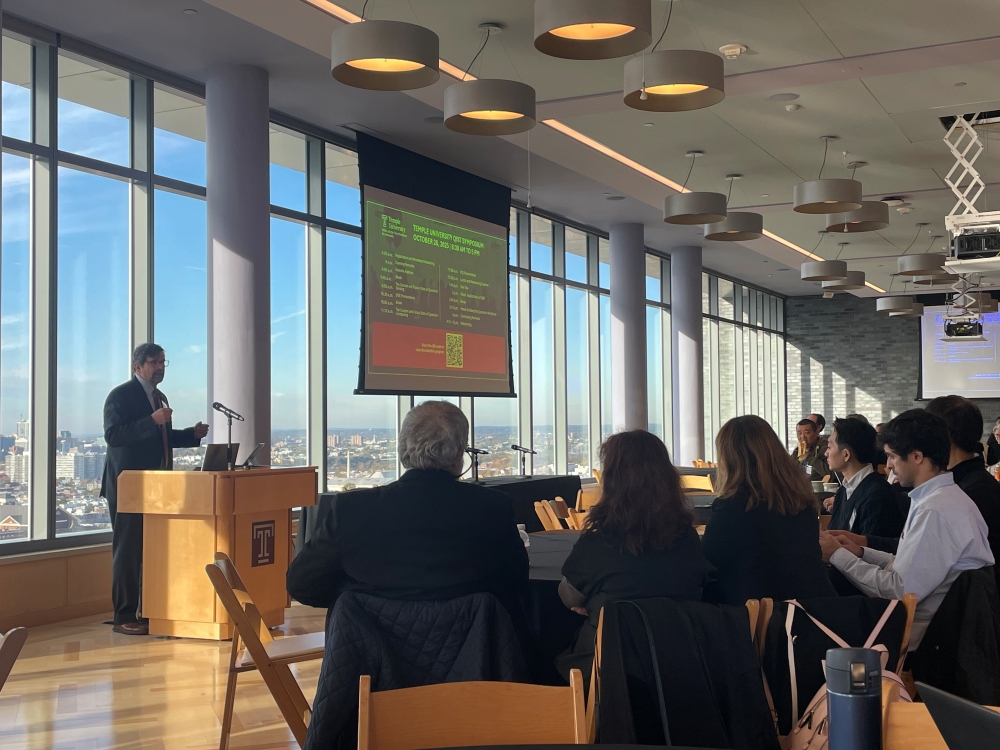Temple University is at the forefront of quantum workforce development, and its Quantum Information Science and Technology (QIST) Symposium made that leadership clear.
Held October 28, 2025 at Morgan Hall, the symposium brought together over 110 researchers and innovators from across academia, entrepreneurs as well as policymakers to explore how quantum technology applications are moving from theory to practice. The event was part of Temple's Semester of Quantum and recognized by the United Nations' International Year of Quantum Science and Technology.
"This year marks 100 years since the foundation of quantum mechanics," said Josh Gladden, vice president for research and professor of physics at Temple. "We're now living in the moment when quantum ideas are becoming quantum tools. Our role is to help ensure those tools are accessible across disciplines – from business and health sciences to materials research and data analytics."
Quantum technology across disciplines
The QIST Symposium showcased how quantum technologies are reshaping industries as diverse as finance, health care and energy. Keynote speaker Patrick T. Harker, Rowan Distinguished Professor at the Wharton School and former president of the Federal Reserve Bank of Philadelphia, said the next wave of discovery will redefine how organizations process information and manage risk.
"Quantum computing isn't just a physics problem – it's an information problem," Harker told attendees. "In finance, quantum algorithms could change how we model uncertainty, secure transactions and optimize entire markets. Universities that teach students to think in quantum terms will give their graduates a tremendous advantage."
Anna Grassellino, director of the Department of Energy's National Quantum Information Science SQMS Center at Fermilab, said the field has reached a pivotal moment. “We are at the beginning of a new era where quantum systems are leaving the lab and becoming usable technologies,” she said. “This is no longer about proving principles – it’s about building tools that work reliably in the real world.” That effort includes Temple as one of the SQMS Center’s partner institutions, where researchers across the nation are advancing superconducting materials that support the center’s mission.
Quantum sensing applications, including new biomedical imaging methods, environmental modeling tools and precision manufacturing processes, were also discussed as examples of interdisciplinary quantum research with broad social impact. "Quantum innovation happens at the intersections," said Pedro Rivero of IBM. "You need physicists, engineers and data scientists working together, and you need institutions like Temple that can bridge those communities."
That collaborative spirit was reflected in participation from institutions including Northeastern University and the Pittsburgh Quantum Institute, whose researchers shared insights on quantum sensing, computation and materials. Their involvement underscored the regional and national scope of the conversations happening at Temple and the shared goal of building a stronger quantum research and education network. Gurudev Dutt of the Pittsburgh Quantum Institute and associate professor in the Department of Physics at the University of Pittsburgh, noted that “collaboration across universities and national labs is what will ultimately make these technologies practical.”
Building a quantum-ready workforce
A major focus of the symposium was the urgent need to build a quantum-ready workforce – not only by preparing students but also by upskilling today’s workforce. Jen Gilburg, deputy secretary for technology and entrepreneurship at Pennsylvania's Department of Community and Economic Development, emphasized preparing the next generation requires both early exposure and equitable access. "We can't wait until graduate school to start," she said. "Students need hands-on exposure earlier, in high school and community college. Access has to be part of the equation if we want a diverse, competitive workforce."
That focus on access and engagement was echoed by speakers who noted that workforce readiness must extend beyond classrooms to meet the needs of emerging industries. Sunil Wattal, associate dean for research and doctoral programs at Temple's Fox School of Business, said industries will increasingly demand hybrid roles that bridge technology, management and data analysis. "We're entering a time when we'll need not just quantum scientists but quantum data engineers and even quantum managers," Wattal said. "It's a career for the future, where understanding both the technology and its implementation will matter equally."
The symposium underscored how work happening in Philadelphia’s growing innovation ecosystem connects to a larger national effort to advance quantum science and workforce readiness. "Quantum is not a future technology – it's today's frontier," Gladden said in closing. "Our goal is to make sure Philadelphia isn't just following the wave but helping to steer it."
Arun Bansil, University Distinguished Professor of Physics at Northeastern University, praised the event’s impact. “It was a fantastic symposium. The quality of the presentations and discussions made for a stimulating event,” he said. “This is exactly the kind of forum our field needs – bringing together diverse perspectives from many disciplines while maintaining scientific rigor. Congratulations on creating such a successful event.”

